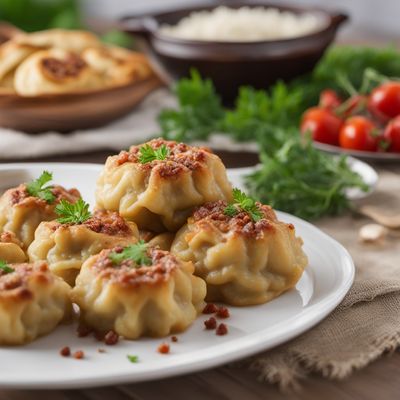
Ingredient
Filled (stuffed) pastas
The Art of Filling: Exploring the World of Stuffed Pastas
Filled pastas are made by encasing a variety of delicious fillings within a thin layer of pasta dough. The fillings can range from savory options like cheese, meat, or vegetables to sweet variations with fruits or chocolate. The pasta dough is carefully rolled out and shaped into different forms, such as tortellini, ravioli, or agnolotti, to hold the filling securely. The resulting dish showcases a beautiful contrast between the tender pasta and the rich, flavorful filling. Filled pastas can be boiled, baked, or pan-fried, and they offer a delightful combination of textures and flavors in every bite.
Origins and history
The origins of filled pastas can be traced back to ancient times, with variations found in different cultures around the world. In Italy, stuffed pastas have a rich history dating back to the Roman Empire. The art of making filled pastas was perfected in the regions of Emilia-Romagna and Piedmont, where traditional recipes like tortellini and agnolotti originated. These dishes were initially prepared for special occasions and celebrations, showcasing the culinary skills and creativity of Italian cooks. Over time, filled pastas gained popularity and spread to other parts of Europe and the world, becoming a beloved staple in Italian cuisine and beyond.
Nutritional information
Filled pastas are a good source of carbohydrates, protein, and essential nutrients. The nutritional content varies depending on the filling and the type of pasta used. On average, a serving of filled pasta contains approximately 200-300 calories, with varying amounts of fat, fiber, and vitamins depending on the specific ingredients used.
Allergens
Filled pastas may contain allergens such as wheat (gluten), dairy (cheese fillings), eggs, and meat. It is important to check the ingredients and labels for any potential allergens before consuming.
How to select
When selecting filled pastas, look for options that have a thin and evenly rolled pasta dough, ensuring a delicate texture when cooked. The filling should be well-distributed and generously portioned, providing a satisfying bite. Freshly made or artisanal filled pastas are often of higher quality compared to pre-packaged options. Additionally, consider the freshness and quality of the ingredients used in the filling, opting for options with natural and flavorful ingredients.
Storage recommendations
Filled pastas are best enjoyed fresh, but if you have leftovers, store them in an airtight container in the refrigerator for up to 3 days. To maintain their freshness and prevent them from sticking together, lightly dust the pasta with flour or semolina before storing. Avoid freezing filled pastas, as the texture may become compromised.
How to produce
Producing filled pastas at home can be a rewarding culinary experience. Amateur cooks can make their own filled pastas by preparing the pasta dough from scratch, rolling it out thinly, and then filling it with their desired ingredients. There are various pasta machines and molds available that can assist in shaping the pasta. With practice and patience, homemade filled pastas can rival those found in professional kitchens.
Preparation tips
To cook filled pastas, bring a large pot of salted water to a boil and carefully add the pasta. Cook according to the package instructions or until the pasta is al dente, tender but still slightly firm to the bite. Avoid overcooking, as the delicate filling may burst or become mushy. Once cooked, drain the pasta gently and toss it with your desired sauce or simply drizzle with olive oil and sprinkle with grated cheese. Filled pastas can be served as a main course, accompanied by a flavorful sauce, or added to soups for a comforting and hearty meal.
Culinary uses
Filled pastas are incredibly versatile and can be used in a variety of culinary creations. They can be served as a standalone dish, accompanied by a flavorful sauce or tossed with herbs and butter for a simple yet satisfying meal. Filled pastas can also be added to soups, enhancing their flavor and texture. Additionally, they can be baked with cheese and sauce for a delicious pasta bake or used as a filling in lasagna. The possibilities are endless, allowing for creativity and experimentation in the kitchen.
Availability
Filled pastas are commonly available in regions with a strong Italian culinary influence, such as Italy, Europe, North America, and other parts of the world with Italian-inspired cuisines. They can be found in specialty Italian markets, gourmet food stores, and some supermarkets. Additionally, many restaurants offer a variety of filled pasta dishes on their menus.
More ingredients from this category
Recipes using Filled (stuffed) pastas » Browse all

Leonese-style Empanadas
Savory Delights: Leonese-style Empanadas with a Twist

Fylla - Icelandic Stuffed Pancakes
Savory Delights: Icelandic Stuffed Pancakes with a Twist

Japanese Rolled Omelette
Savory Delight: The Art of Japanese Rolled Omelette

Indonesian Stuffed Pancake
Savory Delight: Indonesian Stuffed Pancake with a Twist

North Indian Style Stuffed Dumplings
Spiced Delights: North Indian Stuffed Dumplings

Asunción-inspired Spinach Empanadas
Savory Delights from Asunción: Spinach Empanadas with a Paraguayan Twist

Homemade Pheasant Ravioli with Sage Butter Sauce
Savory Delight: Handcrafted Pheasant Ravioli in Fragrant Sage Butter

Pardulas - Sardinian Sweet Cheese Pastries
Heavenly Sardinian Delights: Pardulas - Sweet Cheese Pastries

Armenian Stuffed Flatbread
Savory Delight: Armenian Stuffed Flatbread

Pierogi with a Latin Twist
Empanadas de Pierogi: A Fusion of Polish and Latin Flavors

Pastel de Chaves
Golden Delights: Authentic Portuguese Pastel de Chaves

Khanum Budu - Azerbaijani Stuffed Dumplings
Savory Delights: Irresistible Azerbaijani Stuffed Dumplings

